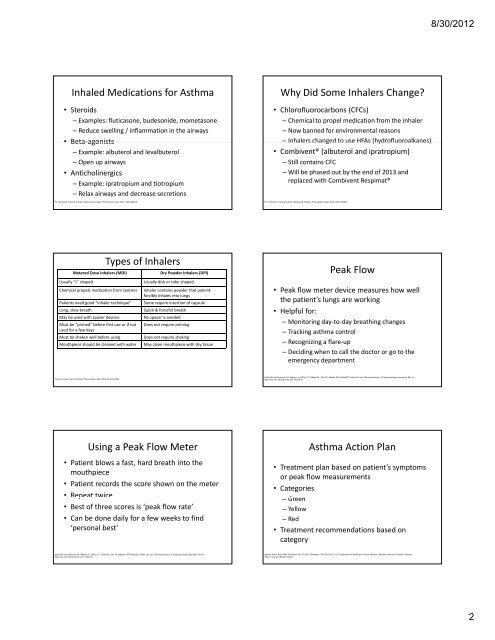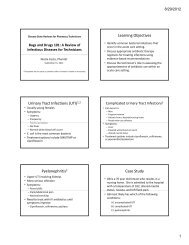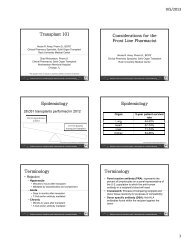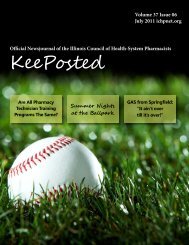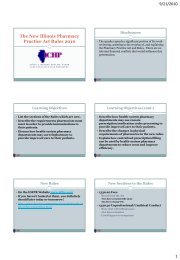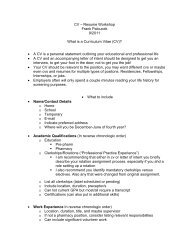Presentation Outline ICHP Annual Meeting September 13-15
Presentation Outline ICHP Annual Meeting September 13-15
Presentation Outline ICHP Annual Meeting September 13-15
Create successful ePaper yourself
Turn your PDF publications into a flip-book with our unique Google optimized e-Paper software.
Inhaled Medications for Asthma<br />
• Steroids<br />
– Examples: fluticasone, budesonide, mometasone<br />
– Reduce swelling / inflammation in the airways<br />
• Beta‐agonists<br />
Beta agonists<br />
– Example: albuterol and levalbuterol<br />
– Open up airways<br />
• Anticholinergics<br />
– Example: ipratropium and tiotropium<br />
– Relax airways and decrease secretions<br />
PL Technician Training Tutorial, Dispensing Inhalers. Pharmacist's Letter 2012; 28(2):280230<br />
Types of Inhalers<br />
Metered Dose Inhalers (MDI) Dry Powder Inhalers (DPI)<br />
Usually “L” shaped Usually disk or tube shaped<br />
Chemical propels medication from canister Inhaler contains powder that patient<br />
forcibly inhales into lungs<br />
Patients need good “inhaler technique” Some require insertion of capsule<br />
Long, slow breath Quick & forceful breath<br />
May be used with spacer devices No spacer is needed<br />
Must be “primed” before first use or if not<br />
used for a few days<br />
Does not require priming<br />
Must be shaken well before using Does not require shaking<br />
Mouthpiece should be cleaned with water May clean mouthpiece with dry tissue<br />
Tips for Correct Use of Inhalers. Pharmacist's Letter 2008; 24(4):240406<br />
Using a Peak Flow Meter<br />
• Patient blows a fast, hard breath into the<br />
mouthpiece<br />
• Patient records the score shown on the meter<br />
• Repeat twice<br />
• Best of three scores is ‘peak flow rate’<br />
• Can be done daily for a few weeks to find<br />
‘personal best’<br />
Kelly HW and Sorkness CA. Asthma. In: DiPiro JT, Talbert RL, Yee GC, Matzke GR, Wells BG, Posey LM, eds. Pharmacotherapy: A Pathophysiologic Approach. 8th ed.<br />
New York, NY: McGraw-Hill; 2011:439-470.<br />
Why Did Some Inhalers Change?<br />
• Chlorofluorocarbons (CFCs)<br />
– Chemical to propel medication from the inhaler<br />
– Now banned for environmental reasons<br />
– Inhalers aesc changed a gedto to use HFAs s (hydrofluoroalkanes)<br />
( yd o uo oa a es)<br />
• Combivent® (albuterol and ipratropium)<br />
– Still contains CFC<br />
– Will be phased out by the end of 20<strong>13</strong> and<br />
replaced with Combivent Respimat®<br />
PL Technician Training Tutorial, Dispensing Inhalers. Pharmacist's Letter 2012; 28(2):280230<br />
Peak Flow<br />
• Peak flow meter device measures how well<br />
the patient’s lungs are working<br />
• Helpful for:<br />
– MMonitoring it i day‐to‐day d t d breathing b thi changes h<br />
– Tracking asthma control<br />
– Recognizing a flare‐up<br />
– Deciding when to call the doctor or go to the<br />
emergency department<br />
Kelly HW and Sorkness CA. Asthma. In: DiPiro JT, Talbert RL, Yee GC, Matzke GR, Wells BG, Posey LM, eds. Pharmacotherapy: A Pathophysiologic Approach. 8th ed.<br />
New York, NY: McGraw-Hill; 2011:439-470.<br />
Asthma Action Plan<br />
• Treatment plan based on patient’s symptoms<br />
or peak flow measurements<br />
• Categories<br />
– GGreen<br />
– Yellow<br />
– Red<br />
• Treatment recommendations based on<br />
category<br />
Asthma Action Plan. (NIH Publication No. 07-5251). Bethesda, MD: April 2007. U.S. Department of Health and Human Services. National Institutes of Health. National<br />
Heart, Lung, and Blood Institute.<br />
8/30/2012<br />
2


